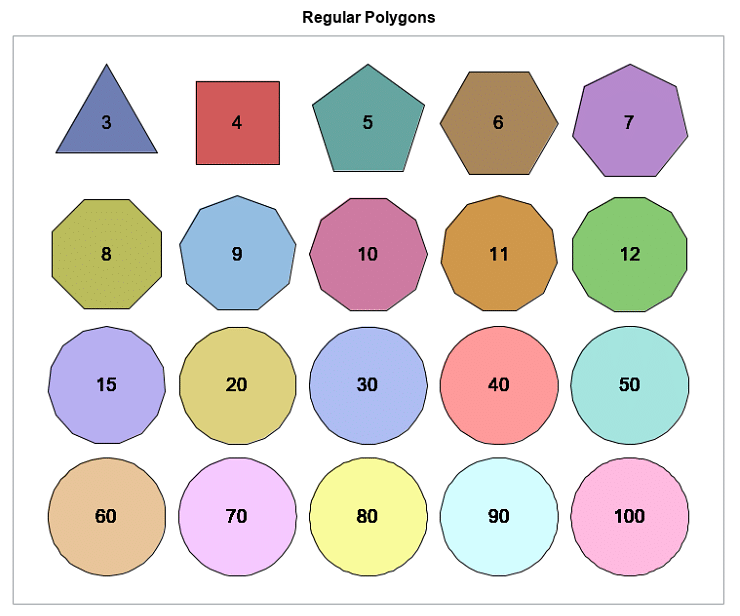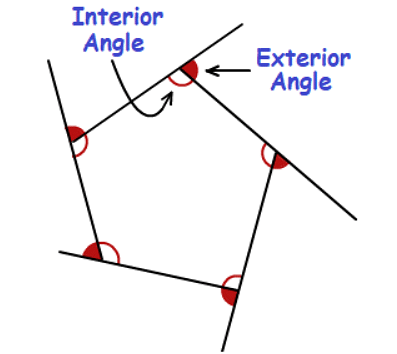
Collegedunia Team Content Curator
Content Curator
Exterior angles of a polygon are the angles present outside of the polygon. They are formed between one of the sides of a polygon and an adjacent side being extended. These exterior angles have their own properties and are used to find out the measure of unknown angles, number of sides of polygon etc.
| Table of Content |
Keyterms: Exterior angles, Polygon, Triangle, Square, Rectangle, Pentagon, Hexagon, Geometry
What is Polygon?
A polygon is a two-dimensional, closed figure formed by joining three or more straight sides. A polygon can form different types of shapes depending upon the number of sides it has. Triangle, square, rectangle, pentagon, hexagon etc. all are polygons with a definite number of sides and angles.

Polygons
Read Also:
Types of Polygon
On the basis of properties of their sides and angles, polygons are of following types:
- Regular Polygon: Regular polygons are polygons whose all sides and angles are equal. For example, square, equilateral triangle etc.
- Irregular Polygon: Irregular polygons are polygons whose sides and angles are not equal in measure. For example, rectangle, parallelogram, scalene triangle etc.

Types of Polygon
- Concave Polygon: If the measure of any one or more than one angle of a polygon is greater than 180°, it is called Concave Polygon.
- Convex Polygon: If all the angles of a polygon are less than 180°, it is called Convex Polygon.
Read Also:
Interior and Exterior Angles of a Polygon
In a polygon, there are two types of angles formed:
- The angles which are formed inside the polygon, between two adjacent sides are called Interior Angles.

Interior and Exterior Angles
- The angles which are formed outside the polygon, between two adjacent sides out of which one is being extended are called Exterior Angles.
The sum of interior angles of a polygon can be found by multiplying the number of triangles formed in a polygon by 180°. This is because the sum of all the angles of a triangle is always 180°. The number of triangles formed in a polygon is always two less than the number of sides of that polygon.
Therefore, the sum of interior angles of a polygon can be calculated using the formula:
(n - 2) × 180° [n = no. of sides of the polygon]
The sum of exterior angles of a polygon is different from that of interior angles. The properties of exterior angles of a polygon are as follows:
- The exterior angles of a polygon when added gives a total of 360°.
- The exterior angle and its corresponding interior angle in a polygon are supplementary (i.e their sum is equal to 180°)
- In a regular polygon, all the exterior angles have the same values.
Read More: Surface areas
Polygon Exterior Angle Sum Theorem
According to this theorem, in a convex polygon, the sum of all the exterior angles is equal to 360°.
This can be proved in the following way;
We know that sum of interior angles of a polygon is given by 180° × (n-2)
where n is the number of sides of the polygon
So, the measure of each interior angle of the polygon will be 180° × (n-2) / n
As we know, in a polygon, the sum of an exterior angle and its corresponding interior angle is equal to 180° (since they form a linear pair).
So, measure of an exterior angle = 180° - 180° × (n-2)/ n
= [180n - 180n + 360]/ n
= 360/n
Hence, the sum of all the exterior angles of the polygon is n × 360/n = 360°
Read Also:
Things to Remember
- A polygon is a closed, two-dimensional figure having three or more straight sides forming different shapes.
- Exterior angles are the angles formed between two adjacent sides of a polygon, one side being extended. They are formed outside the polygon.
- In a regular polygon, the measure of all the sides and angles are equal. If they are unequal, it is an irregular polygon.
- In a polygon, the sum of interior angles can be calculated using the formula 180° × (n-2), where n is the number of sides of the polygon.
- In a polygon, the sum of exterior angle and its corresponding interior angle is 180°.
- According to the Polygon Exterior Angle Sum theorem, the sum of all the exterior angles in a convex polygon is equal to 360°.
Also Read:
Sample Questions
Ques. Find the number of sides of a regular polygon whose each exterior angle has a measure of 45°. (2 marks)
Ans. Sum of all exterior angles = 360°
Measure of each exterior angle = 45°
Therefore, the number of exterior angles = 360/45 = 8
The polygon has 8 sides.
Ques. The exterior angles of a pentagon are (m + 5)°, (2m + 3)°, (3m + 2)°, (4m + 1)° and (5m + 4)° respectively. Find the measure of each angle. (3 marks)
Ans. Sum of all exterior angles of a pentagon = 360°
So, (m + 5)° + (2m + 3)° + (3m + 2)° + (4m + 1)° + (5m + 4)° = 360°
m + 5 + 2m + 3 + 3m + 2 + 4m + 1 + 5m + 4 = 360°
15m + 15 = 360°
15m = 360 - 15°
15m = 345°
m = 345/15
m = 23°
Now, we can find the measure of each angle
First angle, m + 5° = 23° + 5° = 28°
Second angle, 2m + 3° = 46° + 3° = 49°
Third angle, 3m + 2° = 69° + 2° = 71°
Fourth angle, 4m + 1° = 92° + 1° = 93°
Fifth angle, 5m + 4° = 115° + 4° = 119°
Also Read: Section Formula
Ques. Is it possible to have a regular polygon whose each exterior angle is 50°? (2 marks)
Ans. The measure of each exterior angle of a polygon = 360/n
So, 360/n = 50°
n = 7.2
No, we cannot have a regular polygon with each exterior angle 50°.
Ques. Find the measure of each interior angle of a regular polygon having (3 marks)
(1) 10 sides
(2) 15 sides
Ans. Each exterior angle = 360/n (n = no. of sides of polygon)
- Exterior angle = 360/ 10 = 36°
Each interior angle = 180 - 36 = 144°
- Exterior angle = 360/ 15 = 24°
Each interior angle = 180 - 24 = 156°
Ques. In the given figure, find the value of angle x. (5 marks)

Ans. Sum of all the interior angles of an n-sided polygon = (n-2) × 180°
∠ADC = 180 - 50 = 130°
∠DAB = 180 - 115 = 65°
∠BCD = 180 - 90 = 90°
∠ADC + ∠DAB + ∠BCD + ∠ABC = (n-2) × 180° = (4 - 2) × 180° = 360°
So, 130° + 65° + 90° + ∠ABC = 360°
285° + ∠ABC = 360°
∠ABC = 360° - 285° = 75°
∠CBF = 180 - 75 = 105°
x = 105°
Ques. Find the angle x in the given figure. (3 marks)

Ans. For a regular polygon with n sides,
Each interior angle = 180 - (360/n)
Here, n = 5
x° = 180 - (360/5)
x° = 180 - 72
x° = 108°
Therefore, in the given figure x = 108°
Ques. The sides of a hexagon are produced in order. If the measure of the exterior angles obtained are (3x-5)°, (8x+3)°, (7x-2)°, (4x+1)°, (6x+4)° and (2x-1)°. Find the value of x. (2 marks)
Ans. Sum of all the exterior angles = 360°
(3x-5)°+ (8x+3)°+ (7x-2)°+ (4x+1)°+ (6x+4)° + (2x-1)° = 360°
30x = 360°
x = 12°
Read More: Pythagoras Theorem
Ques. The ratio between the exterior angle and the interior angle is 2:7. Find the number of sides of the polygon. (3 marks)
Ans. Interior angle = 180° - Exterior angle
Let the exterior angle be 2x and the interior angle is 7x.
2x + 7x = 180
x = 20°
So, interior angle = 7 × 20 = 140°
Number of sides (n) = 360° / 180° - 140° = 9
Ques. The sum of all the interior angles of a regular polygon is twice the sum of exterior angles. Find the number of sides of the polygon. (3 marks)
Ans. Sum of interior angles = (2n - 4) × 90°
Sum of exterior angles = 360°
According to question, sum of interior angles = 2 × sum of exterior angles
(2n - 4) × 90° = 2 × 360°
(2n - 4) × 90° = 720°
n = 6
Thus, the polygon has 6 sides.
Ques. Find the number of sides of a regular polygon whose each exterior angle has a measure of 60°. (2 marks)
Ans. Sum of all exterior angles = 360°
Measure of each exterior angle = 60°
Therefore, the number of exterior angles = 360/60 = 6
The polygon has 6 sides or it is a hexagon.








Comments